A 2-day Private Tour in North Norfolk, for a couple of recent recruits to birdwatching, looking for a broad selection of our regular birds. The weather was on 28th was much better than expected, with sunshine all day and no sign of the forecast showers in the afternoon. It was cloudier on 29th, still bright in the morning but darker and more threatening, and windier with it in the afternoon. Thankfully the rain didn’t arrive until later in the day, long after we had finished.
On our first morning, we headed for Cley. There were three Green Sandpipers and a couple of adult Water Rails on Snipe’s Marsh and as we set off up the East Bank, an adult and a fully grown juvenile Little Grebe were on Don’s Pool. A Reed Bunting perched obligingly in one of the small willows in the reeds, where a Reed Warbler flicked around in the leaves too, but a Cetti’s Warbler was only heard and remained typically out of view. We looked and listened for Bearded Tits along here today, but it was perhaps a little too breezy.
Six Spoonbills flew west over the bank ahead of us and appeared to drop down on the main scrapes. There were quite a few waders distantly on Pope’s Pool which we scoped from the bank. Most notably a Wood Sandpiper and a single juvenile Curlew Sandpiper in with the small flock of Dunlin. A juvenile Bar-tailed Godwit dropped in too. Further up on the Serpentine, we had much closer views of two more Curlew Sandpipers with more Dunlin, and several nice scaly juvenile Ruff. A single Common Snipe was feeding along the reedy edge.

On Arnold’s Marsh, there was a large flock of Sandwich Terns over towards the back. We could see the Long-billed Dowitcher out in the middle, asleep in a group of Black-tailed Godwits, but we figured it would be a better view from the old shingle ridge. A single Ringed Plover was on the Brackish Pools the other side and a Little Egret and several Redshanks on the pools below the bank as we walked up to the beach.
We had a quick look at the sea, but there was not much out here now, so we walked a little further east and had another look at the waders. The Long-billed Dowitcher eventually woke up and flashed its long bill, and we also found a Whimbrel, three Knot and two Greenshank on Arnold’s Marsh from here. Several Linnets and Meadow Pipits flicked around in and out of the grass. On the way back, three more Curlew Sandpipers dropped in with the Dunlin and the other two on the Serpentine giving us some very nice views.
We stopped for lunch back at the Visitor Centre, and in the afternoon we made our way along the coast to Stiffkey. A Hummingbird Hawkmoth flew off ahead of us as we walked along the permissive path by the road. There were a few birds by the river, a couple of Bullfinches flew out calling as we walked along the path, several Chiffchaffs were scattered around the bushes and a small mixed tit flock with a Goldcrest in with them was in the sallows above our heads.
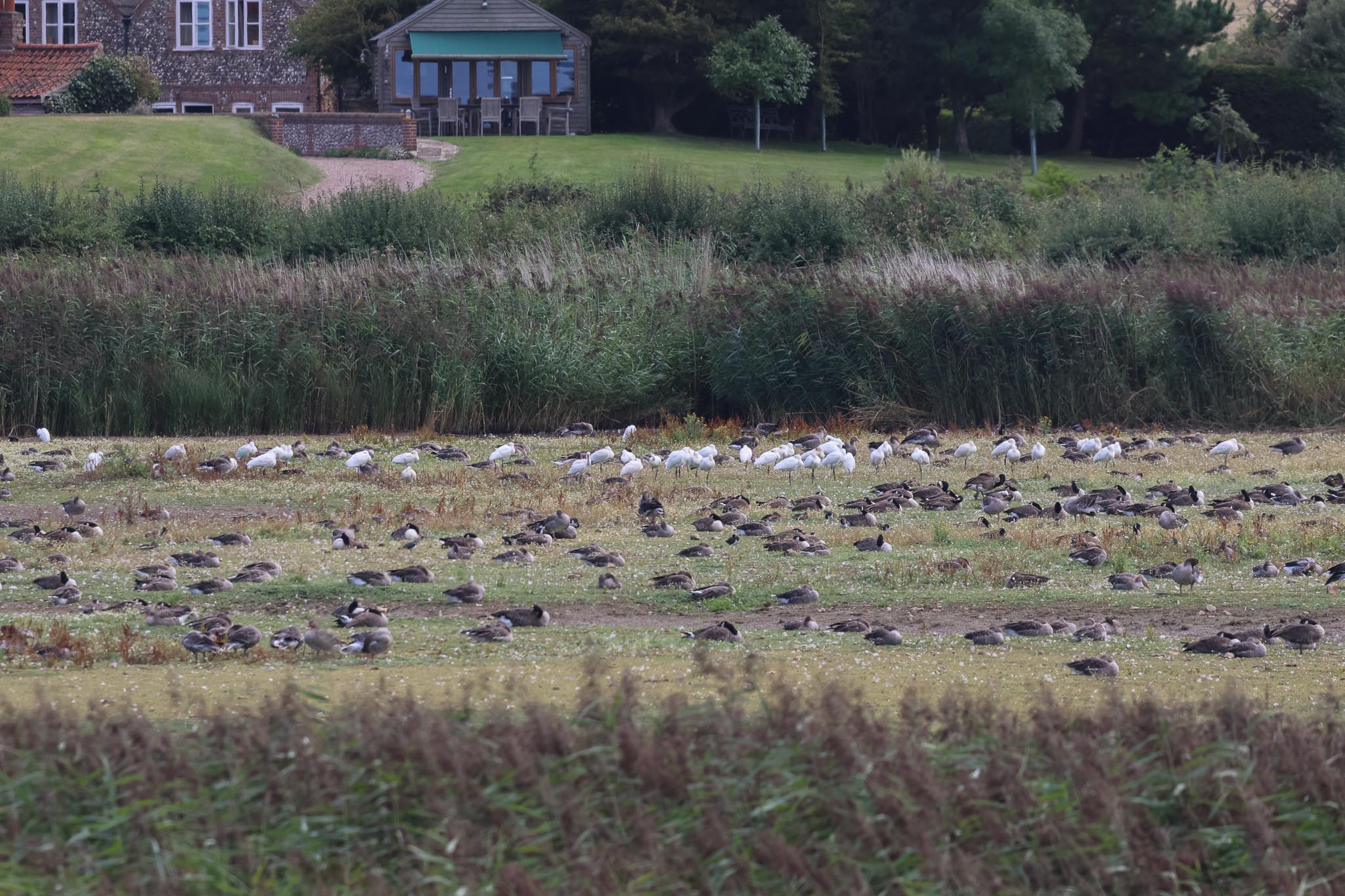
From up on the seawall, we had a good view of the Spoonbill flock – we counted at least 40 on here today, with some still coming and going on the rising tide, including several juveniles. There were lots of Black-tailed Godwits and Redshanks roosting on the pool and three Avocets, including two which we watched bathing in the water. A couple of Green Sandpipers flew round and a Common Sandpiper was feeding on the mud, before flying off past us and disappearing up the creek behind. In among all the geese, we found a few Wigeon and a couple of Pintail, though none of the ducks are looking their best at this time of year.

Looking out towards the Harbour, a flock of fourteen Whimbrel flew round over the saltmarsh, at least four Stonechats were flitting around on the suaeda bushes and we picked up a very distant Marsh Harrier hunting the edge of the Point. From further up the seawall, we could see four Greenshanks out on the Fen too. There were a couple of Turnstones on the edge of the harbour channel as we made our way round and more on the edge of the Pit. A huge flock of Oystercatchers was trying to roost on the far side of the water but kept getting disturbed, and a large mixed flock of Bar-tailed Godwit and Knot flew round too.
We could see lots of gulls in the harbour and looking through, we managed to pick out a single juvenile Caspian Gull. A couple of Guillemots out on the water were a bit of a surprise, and one in particular didn’t look particularly well as it was carried into the mouth of the channel. A pair of Great Crested Grebes were more expected here.
We could see all the Grey Seals hauled out on the end of Blakeney Point from here and there were lots of Sea Aster Bees (Colletes halophilus). on a bank on the edge of the harbour so we stopped to watch them, lots of males swarming over the holes and pouncing on any emerging females. Then it was time to call it a day and walk back.
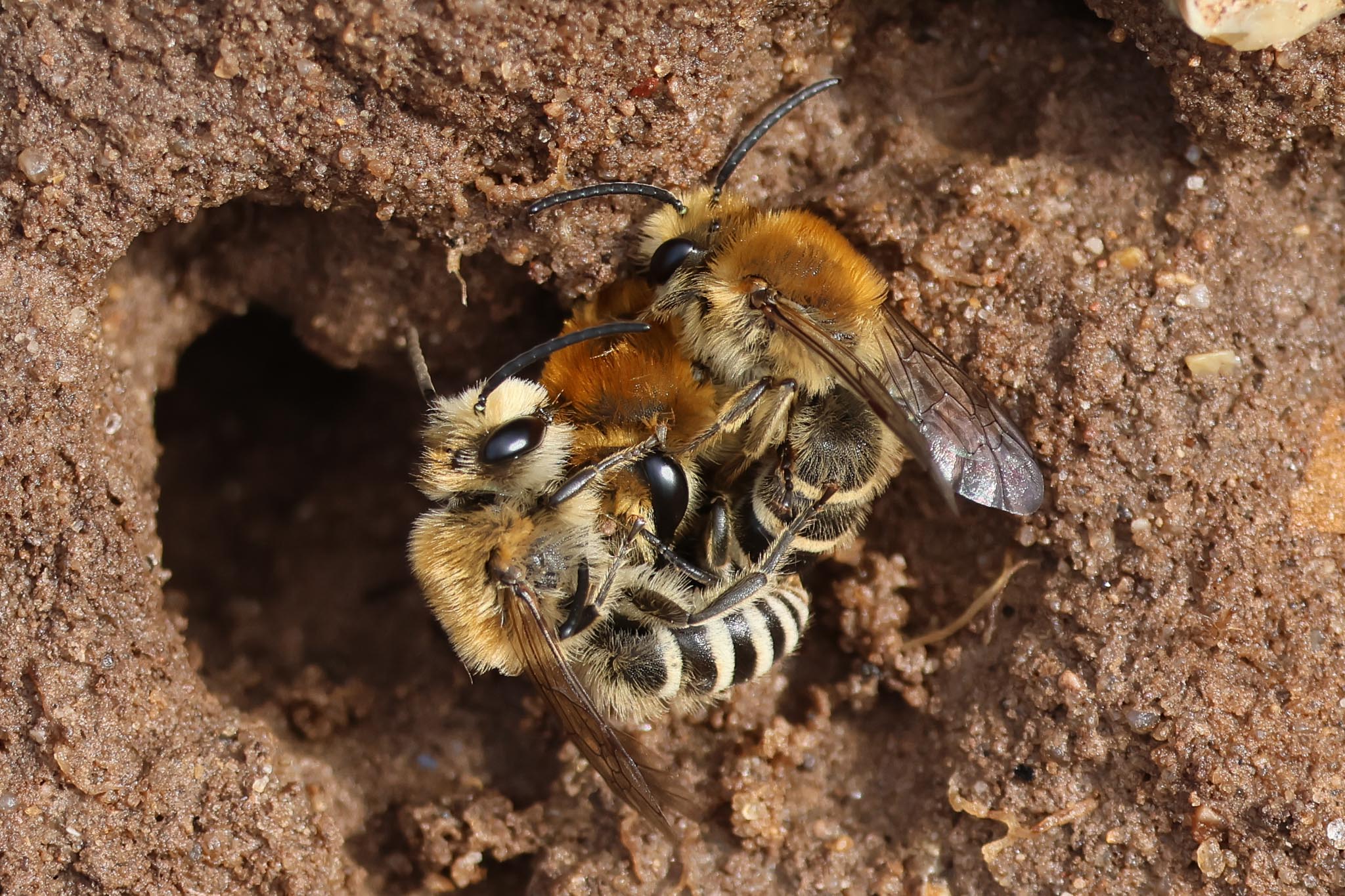
The following morning, we headed for Titchwell first thing. A quick look round the overflow car park before it got too busy produced more Chiffchaffs, several Blackcaps, a single Common Whitethroat and a juvenile Great Spotted Woodpecker which dropped in to a dead tree briefly before continuing on its way east. There were lots of Swallows and House Martins hawking overhead and two Red Kites distantly in the dead trees looking across from the gate by the paddocks.
Out onto the reserve, we walked slowly out past the reedbed, scanning the edges of the pools below the path. There were a few Gadwall in the channels, a couple of Common Pochard on the reedbed pool and two Marsh Harriers quartering over the reeds. Two Bearded Tits appeared and showed very well, as they worked their way round the back of one of the pools, a blue/grey-headed male and a browner female. Two Spoonbills flew over the path and off towards Thornham Harbour, as did most of the Golden Plover which had been roosting on the Freshmarsh. A Greenshank flew round calling and disappeared off west too.
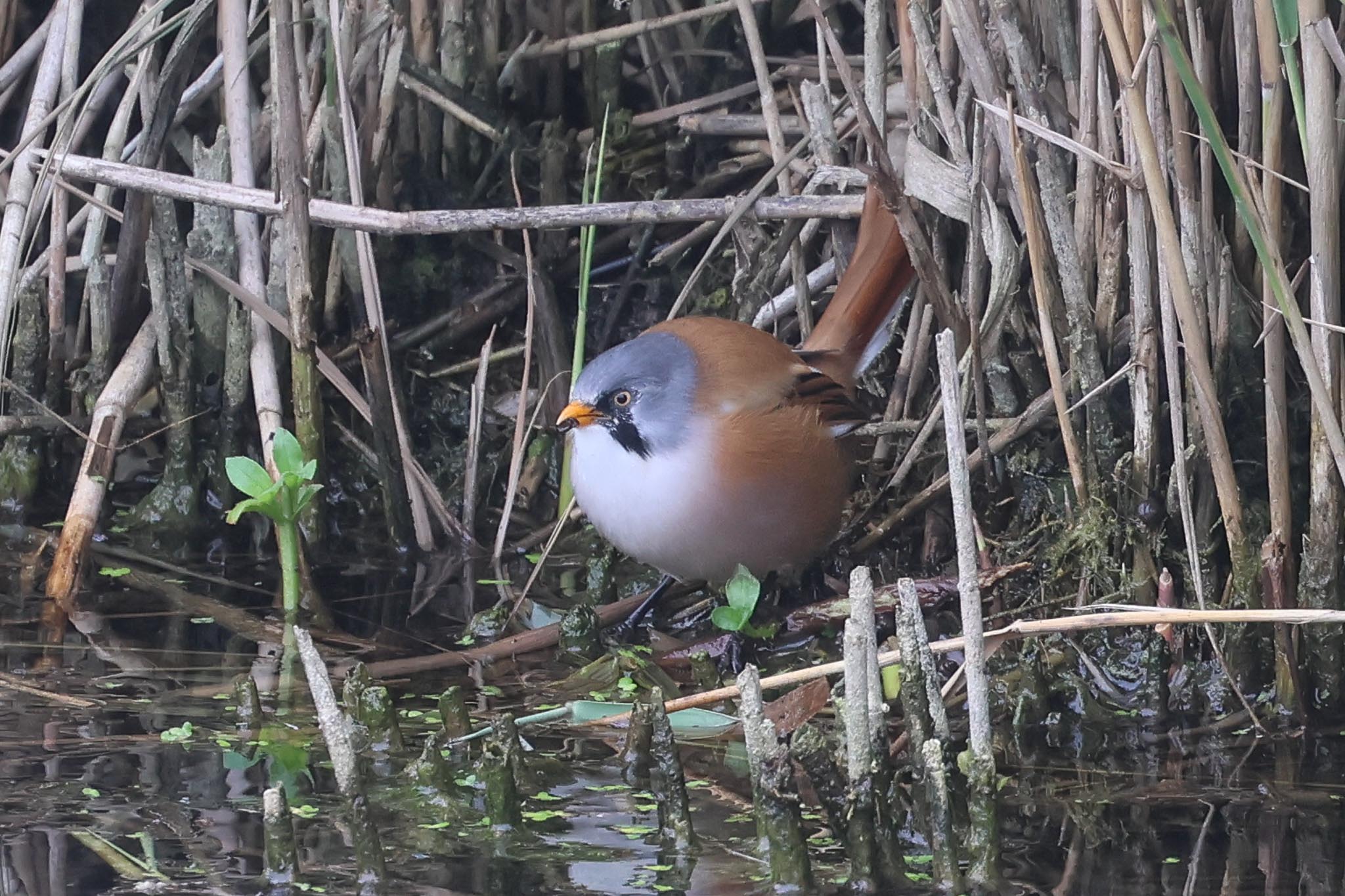
We called in at Island Hide, which gave some very close up views of Avocets and Black-tailed Godwits, particularly a nice smart juvenile Icelandic bird, and Ruff. A Common Snipe was preening on the edge of the bank. We had a look through the ducks, which added Shoveler to the trip list. There were two more Spoonbills out in the middle, one of which was awake and allowed us good views of its bill through the scope.
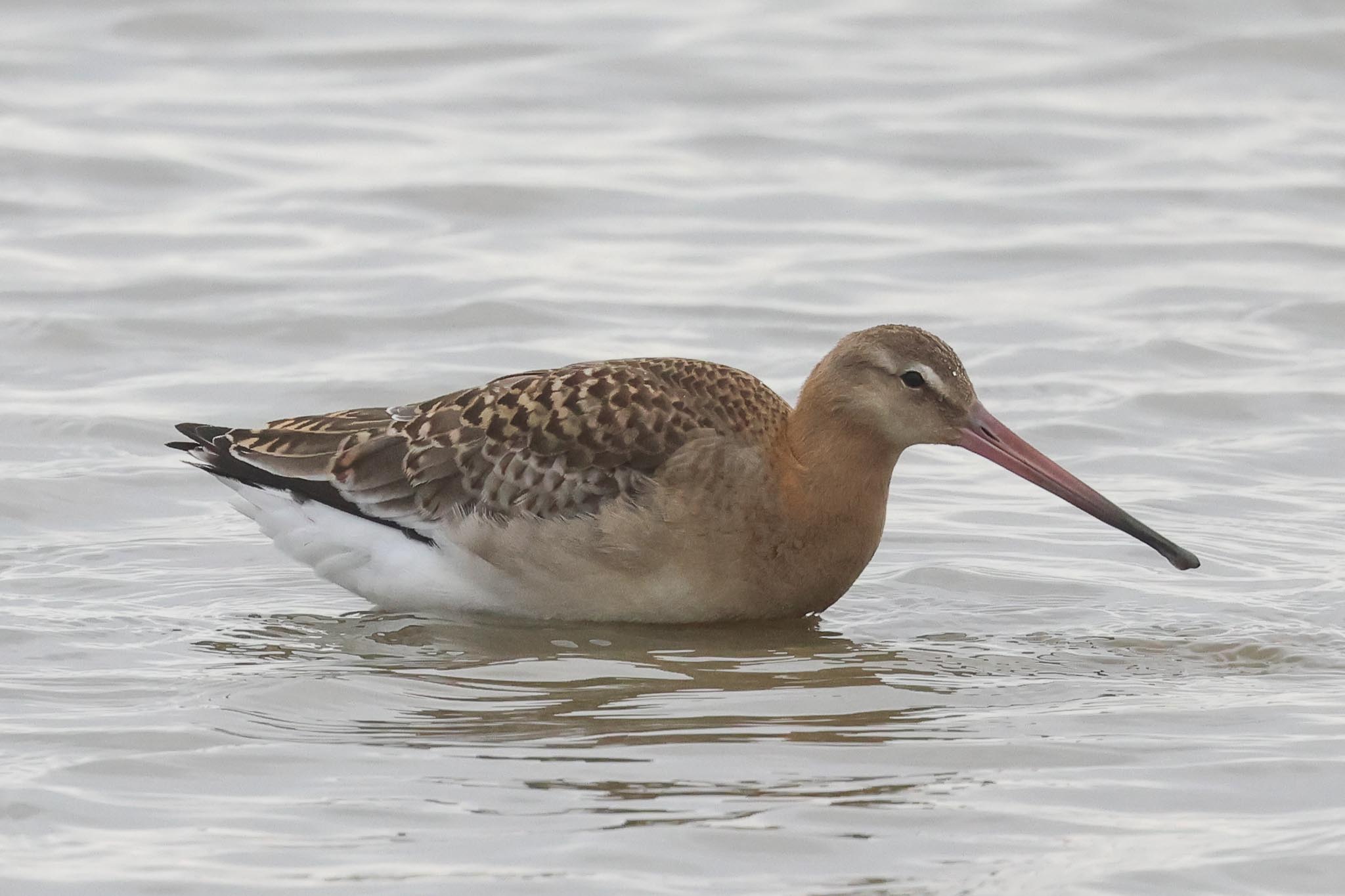
From back out on the main path, there were several more adult Ruff in non-breeding plumage and we stopped to admire the Lapwings on the edge of the bund. Along the path to Parrinder Hide, we found a couple of Wasp Spiders still on their webs in the vegetation on the bank. We scanned the back compartment of the Freshmarsh from the viewing area beyond the hide but could not see the American Golden Plover in the remaining flock of European Golden Plovers now. A pair of Common Terns were still flying in and out bringing food for their young. A juvenile Spoonbill was chasing after its parent begging incessantly.

Continuing on out to the beach, there was not much on Volunteer Marsh – just a couple of Curlews and two Redshanks in the channel on the far side. There were some very nice tame Black-tailed Godwits on the Tidal Pools which we stopped to photograph.
At the beach, the tide was out so we walked down for a closer look at the mussel beds. There were lots of waders, including some smart Bar-tailed Godwits, Turnstone and Grey Plover all still mostly in breeding plumage, along with several juvenile Knot. A small group of Sanderling and a single Ringed Plover flew past. We couldn’t see much out to sea now – a few Gannets flying past in the distance and some closer Sandwich and Common Terns.
We had seen a large flock of Golden Plover behind us from the beach, so we had a quick look back from Parrinder Hide, but there were still not the full flock on the Freshmarsh and no sign of anything different in with the ones which were there. A Whimbrel flew round calling and then disappeared off towards the beach. As we made our way back to the Visitor Centre for lunch, a Yellow Wagtail flew over the path ahead of us and off towards Thornham.
After lunch, we diverted inland. There were lots of Red-legged Partridges along the roads – recently released for the shooting season, they are typically very tame and many were reluctant to fly even ahead of the minibus. There were lots of Linnets and several Pied Wagtails bathing in the puddle in the farmyard. A couple of Common Buzzards were over the fields beyond and a lone Marsh Harrier standing in the stubble. A single Stock Dove was in the middle of a groups of Woodpigeons.
We cut across to the Wash coast. It was not a big high tide today, but we hoped still to catch some waders on the rising tide. When we arrived at Snettisham, there were dark clouds rolling in off the Wash and the wind had picked up. We cut in through the Coastal Park, where the bushes were rather quiet. Lots of Mediterranean Gulls of various ages were streaming overhead, heading down the Wash. As we got up onto the outer seawall, there was still a strip of mud beyond the beach which was covered in waders, large number of Bar-tailed Godwits and Knot and a mass of Oystercatchers gathered further up.
The tide was coming in quickly and they were made more nervous by a dog along the shoreline, taking to the air and flying off past us, further down the Wash. Further out, we could see a much larger dark slick of Oystercatchers out on the mud and some huge smoky clouds of Knot which whirled round from time to time making shapes in the air, presumably stirred up by a raptor of some description.
There was still a nice selection of waders on the beach, and and we thought they might be slowly pushed down towards us by a couple walking along from Heacham. We walked down to the sand but the Whimbrel and remaining Oystercatchers flew off calling before we got there and most of the the Turnstones and Sanderlings flew straight past us before doubling back round and landing further up again.
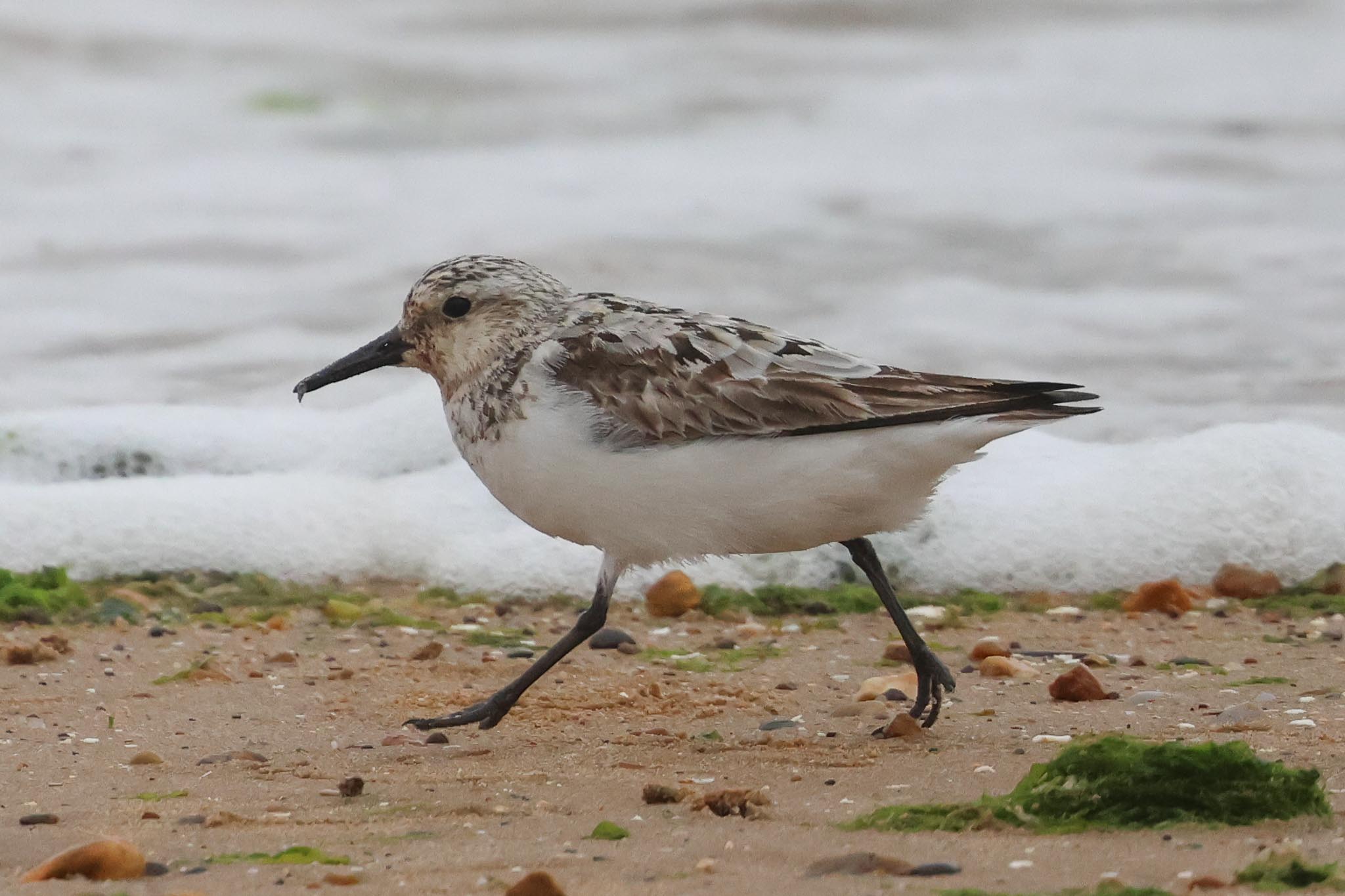
There were still a few birds which were working their way back in our direction along the shoreline so we positioned ourselves ahead of them. We had some lovely views of a young Turnstone which came close past us and a couple of the Sanderlings were just coming towards us when an off-the-lead spaniel came running past and chased all the birds off. Its owner was standing behind and lamely calling it back.
With the weather looking increasingly threatening, it was time to head back. We had enjoyed a very nice couple of days and seen an excellent selection of Norfolk’s birds.
















